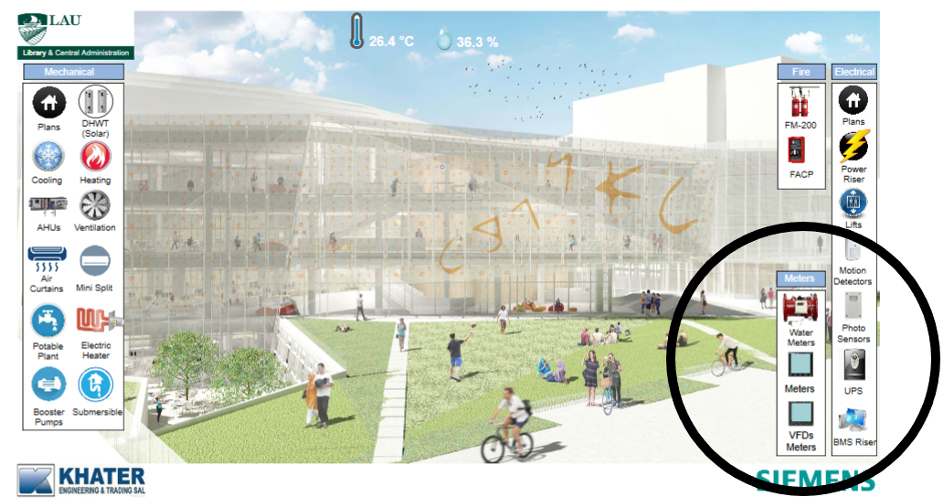Water Extraction Technologies
LAU is committed to sustainable water management through innovative technologies and practices on both its Beirut and Byblos campuses. Recognizing the environmental impact of water extraction and usage, LAU employs integrated systems to optimize water resources while reducing reliance on unsustainable methods.
On the Beirut campus, water for domestic, potable, and irrigation purposes is stored in strategically placed tanks with a total capacity of 2,200 m³. Advanced systems, such as roof stormwater and condensate collection tanks, supplement irrigation needs, ensuring that resources are conserved. Stormwater and sanitary drainage are managed through separate networks that discharge responsibly into municipal systems.
Meanwhile, the Byblos campus leads with sustainable irrigation practices by prioritizing treated wastewater from its central treatment plants. Supplemented by well water only when necessary, this approach is managed by automation controls integrated into the campus’s Building Management System. Additionally, stormwater is responsibly discharged, and wastewater is treated and reused for irrigation and fire-fighting purposes, reducing environmental strain.
These efforts highlight LAU’s holistic approach to water sustainability, aligning infrastructure with environmental responsibility while ensuring that campus operations meet their needs sustainably.
Physical Facilities –Beirut Campus Utilities
Domestic, Irrigation and Potable Water
Water on the Beirut campus is stored in several locations and pumped to dedicated storage tanks serving each building. The total storage capacity is 2,200 m3.
Water treatment plants provide building occupants with adequate drinking water. Irrigation water is stored in dedicated tanks that are also fed by roof storm water and condensate drain collection.
Storm and Sanitary Drainage
Storm water is collected from buildings and terraces and discharged into the municipal network. The sanitary drainage in Beirut campus is collected and discharged into the municipality’s sewage network.
Physical Facilities – Byblos Campus Utilities
 |
 |
 |
 |
 |
 |
Power, Cooling and Heating Plants
Currently, all buildings or clusters of buildings are served by dedicated generators, chillers and boilers.
A major infrastructure project (launched in October 2015) will replace the existing chilled water and heating water systems by new central power, district cooling and district heating plants, all connected to major campus buildings by a series of fully-accessible utility tunnels.
The total chilled water capacity is 12660 KW (3600 TR), consisting of five water cooled chillers, two of which are provisioned for future installation. The total heating capacity is 6,955 KW (1980 TR), consisting of five boilers, two of which are provisioned for future installation. The total power capacity is 9 MW, including four new generators (2000 KW each) and one exiting generator (1000 KW).
Domestic, Irrigation and Potable Water
New central concrete reservoirs with a total capacity of 125 m3 will be erected at the upper campus hill for the storage of domestic, fire protection, irrigation and soft water. The domestic and irrigation water will be separately distributed by gravity to all the buildings in the campus while the firefighting water will be pumped through three electric fire pumps.
Storm and Sanitary Drainage
Storm and sanitary drainage have separate infrastructure. Storm water is being collected from buildings and terraces and discharged into the municipality network.
There are three central sewage treatment plants in the valley with a total capacity of 190 m3/day and one plant at Dorms B, collecting the sewage from the campus for treatment prior to reuse for irrigation and fire-fighting purposes.
Waste Water Treatment Plant

Subject Meters


